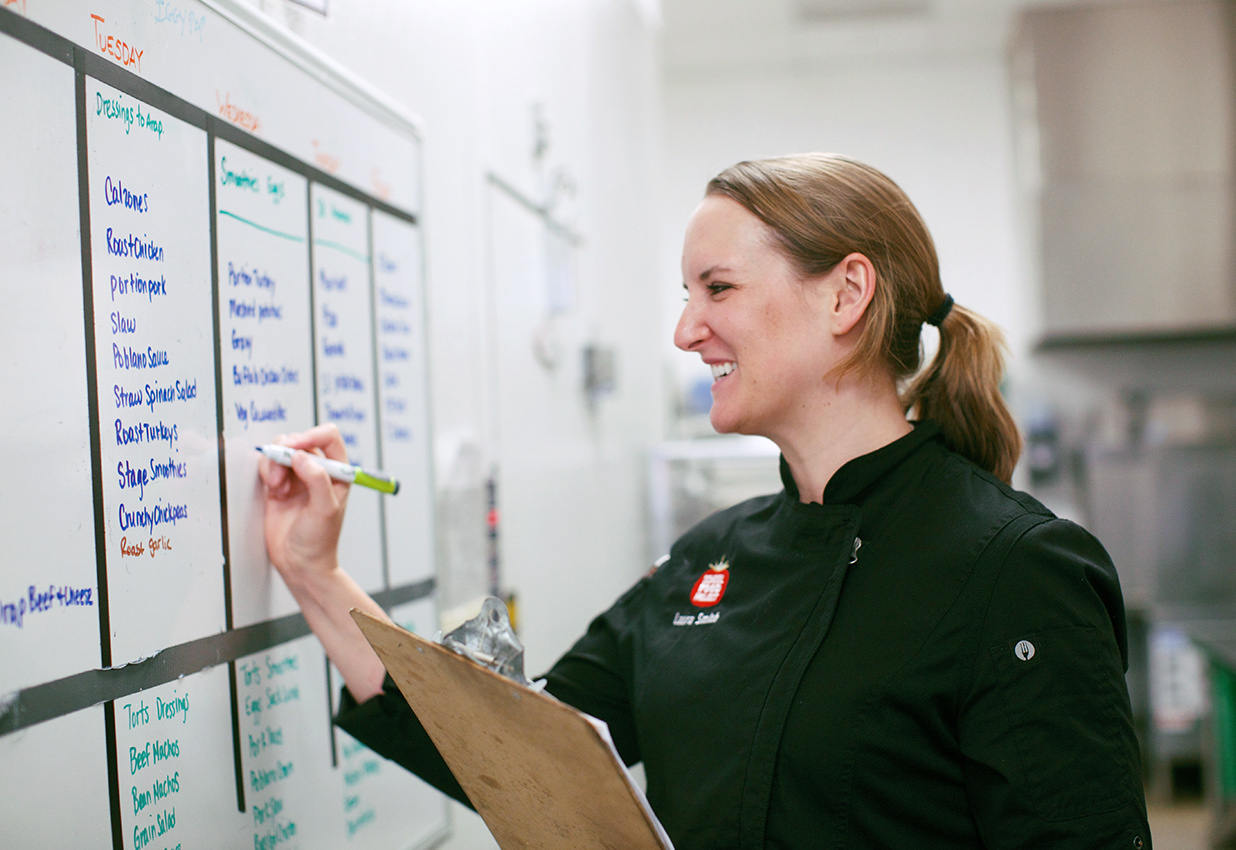
Assessment & Next Steps
Program assessments to identify opportunities and challenges is a key step toward enriching and building stronger food service programs. Evaluation of operations is especially vital for districts beginning or continuing to explore scratch-cook production, local procurement, culinary skills, and service and communication skills, as well as improvements to facilities and other areas.
The primary purpose of self-assessment is to gain an accurate status of current programs and services. By understanding the current fiscal, operational, facilities, human resources, and community relations aspects of your department, you can determine the best course of action and develop a strategy to realize your department’s vision. It can be challenging to step back and critically assess our own practices. The most obvious barrier is time; the secondary barrier is true objectivity.

Assessment & Next Steps
Program assessments to identify opportunities and challenges is a key step toward enriching and building stronger food service programs. Evaluation of operations is especially vital for districts beginning or continuing to explore scratch-cook production, local procurement, culinary skills, and service and communication skills, as well as improvements to facilities and other areas.
The primary purpose of self-assessment is to gain an accurate status of current programs and services. By understanding the current fiscal, operational, facilities, human resources, and community relations aspects of your department, you can determine the best course of action and develop a strategy to realize your department’s vision. It can be challenging to step back and critically assess our own practices. The most obvious barrier is time; the secondary barrier is true objectivity.
In assessments, we emphasize data collection and tracking because in-depth knowledge of the department’s structure and day-to-day activities is essential for districts that want to engage in complex change. A thorough understanding of current operations makes it possible to prioritize goals and develop realistic steps.
Some districts may have specific short-term goals that can be addressed without significant investment of time or resources, but most operational shifts involve a level of complexity that requires strategic planning. Having data in hand makes it easier to identify specific actions required to accomplish your goals.
Mission, Vision & Strategic Planning
School Food Institute
Our online professional development course walks you through the essentials of strategic planning – from baseline program assessment to defining your program’s mission, vision, values, and goals, and developing a multi-year strategic plan to meet your goals for change.
Essential Data
Essential Data for Assessment: Fiscal Management
Collecting and reviewing key fiscal data is fundamental to the assessment process. Though many districts carry out data collection to some extent, food-service departments often neglect to track detail in all categories, and some districts lack efficient software and digital tracking tools.
The following areas are required to establish data sets for your baseline:


Essential Data
Essential Data for Assessment: Fiscal Management
Collecting and reviewing key fiscal data is fundamental to the assessment process. Though many districts carry out data collection to some extent, food-service departments often neglect to track detail in all categories, and some districts lack efficient software and digital tracking tools.
The following areas are required to establish data sets for your baseline:
#1: Labor Costs
As labor is your largest expense, it is important to gain a detailed understanding of what is spent on labor and whether your team is optimized. The labor worksheets track labor cost data, including where each employee is working. As you consider changes to the operational model (like adding salad bars, implementing Breakfast in the Classroom, or shifting to regional or centralized production), tracking the cost of labor and the department’s efficiency in this area is critical.
Hours Assigned to Hours Worked
This is a tracking tool to make sure hours worked do not exceed assigned (budgeted) hours.
Meals Per Labor Hour Worksheet
This worksheet allows for comparisons of site labor allocations to meals provided.
Position Control Spreadsheet
This worksheet identifies personnel by site and provides details of each employee’s associated costs, such as health and welfare, number of days, etc.
Sample Reorganization Worksheet
This shows how to use the data collected in your fiscal assessment to project the kinds of departmental shifts commonly associated with consolidating to a regional or centralized model.


Hours Assigned to Hours Worked
This is a tracking tool to make sure hours worked do not exceed assigned (budgeted) hours.
Meals Per Labor Hour Worksheet
This worksheet allows for comparisons of site labor allocations to meals provided.
Position Control Spreadsheet
This worksheet identifies personnel by site and provides details of each employee’s associated costs, such as health and welfare, number of days, etc.
Sample Reorganization Worksheet
This shows how to use the data collected in your fiscal assessment to project the kinds of departmental shifts commonly associated with consolidating to a regional or centralized model.
#2: Simple Meal Count / Average Daily Participation Worksheet
This worksheet projects anticipated revenue and compares it to budgeted revenue.
#3: Food Cost & Inventory Tracking Tool
This tool projects food costs, compares them to the budget, and tracks inventory.
#4: Breakfast Expansion
Using information collected from the fiscal tools, this worksheet projects expenses and revenues associated with alternative breakfast expansion, like breakfast in the classroom, both on a site-specific basis and for the entire district. (See Breakfast District-Wide Calculator and Breakfast Site Calculator.)
#5: Multi-Year Profit and Loss Statement
A multi-year budget to actual comparison is essential to understand the trends of revenue and spending on your program. This sample sheet uses the data generated in the spreadsheets for labor costs, meal counts, and food costs, along with data that can be pulled from district accounting software, all to produce historical budget comparisons.
Human Resources
In addition to evaluating labor costs, creating a diagram of your Organizational Structure and reviewing the job descriptions related to each position is imperative. Accurate job descriptions provide an effective base for hiring great team members. Are your job descriptions up to date? Are the position titles you have reflective of what you need? Do you have too many titles? Are the hiring qualifications adequate and accurate?
Food and Procurement
How would you characterize your current menus and sources? What direction do you intend to take them? Examining your trends in commodity allocation, commercial procurement, reliance on a la carte sales, use of fresh produce, and procurement of local foods will produce useful information that can help to prioritize next steps. Most importantly, it can help identify low-cost, high-result actions that will move your department toward the realization of its goals.
Facilities
Examining the status of your district’s facilities is another essential process; it should be done on an ongoing basis. Your evaluation should include everything from building access and neighborhood compatibility for truck deliveries to whether the service line has been updated in the last 40 years. Depending on the goals of your program, you may be able to get by with old or outdated equipment for the short term, but it’s important to lay out your long-term needs and make sure that the department is continually evaluating and updating its equipment (see Facilities - Equipment Management section). Use the Salad Bar Site Assessment Tool and the Breakfast Assessment Tool to collect facilities information specific to breakfast and salad bar programs.
Climate for Support: Policies, Marketing, and Community Engagement
The district wellness policy, marketing support, community support of kids’ health, integration of food education, and food literacy are all evaluated when determining how the wider district and community can support food service programs. To evaluate your climate for support, ask the following questions:
- What activities in your district and community can support the program changes you hope to make?
- Does your district have a nutrition or wellness committee (see Wellness Policy and Smart Snacks section)?
- Is there an active grant in the district that includes food service engagement?
- Are school gardens and learning opportunities established in the district?
The answers to these and similar queries will help you evaluate the resources that currently exist and identify others that might be needed to support your particular program improvement.

Identifying Goals
Collecting data on all program aspects gives a solid foundation to work toward desired goals. The fiscal tools can be used to create “what-if” scenarios that will help immediately identify whether you have the required revenue to support a change, and identify areas that can be improved to support change, like lowering food costs or increasing meal counts.
Most goals will require more action than just establishing fiscal support, so collecting data on all current conditions is critical. For example, if the next step is to consolidate the means of production to regional or centralized production for more efficient scratch cooking, the next actions will be dependent on every aspect of the operating system. Are capital improvements required? Do current staff members have enough expertise to handle the shift to a new production method? What kind of changes in procurement will be needed to meet this goal? Do you have support from your superiors and the school board?
Alternatively, another objective might be to establish ServSafe manager certificate training as a regular part of ongoing staff hiring and development process. In this case, you’ll need to ask different questions. What are the barriers to this? Do you have a team member who could become a certified trainer? What would be the annual cost of establishing and then maintaining such a program? Having detailed data about all areas of your programs at your fingertips makes it easy to answer the relevant questions.
Strategic Planning
Strategic Planning for Next Steps
Taking your vision from high-level to detailed requires a strategic planning process. A strategic plan determines the actions, resources, and benchmarks required to reach your goals.
Strategic planning should involve the top members of the management team, the director’s direct supervisor, and other key district administrators, depending on the size of the district and the makeup of its administration. Our Strategic Planning Worksheet Sample identifies next steps and lays out the challenges, known resources, and specific actions, along with the parties responsible and a timeline for each action. When strategic planning, it’s highly advisable to conduct follow-up reviews at regular intervals.
Recommended Next Topic: Provisional Programs
Provisional programs offer an opportunity for districts to reduce paperwork in their efforts to provide a school meal program for their students and possibly increase revenue through greater participation. These programs come from two legislative actions.
Recommended Next Topic: Provisional Programs
Provisional programs offer an opportunity for districts to reduce paperwork in their efforts to provide a school meal program for their students and possibly increase revenue through greater participation. These programs come from two legislative actions.






